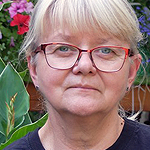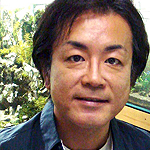Shallow stream in Lotus Mountain, Guangzhou, China
7th place in Biotope Aquarium Design Contest 2019
China. Qi Yin

Volume: 150 L
Dimensions: 100x50x30 cm
List of fishes: Pseudogastromyzon laticeps, Rhinogobius zhoui, Pseudobagrus trilinaetus
List of plants: There are no aquatic plants except for the plants that are submerged during the rainy season.
Description of decorations: The pebbles, rocks and sands were all collected in the river. The shape and color of the selected pebbles, rocks and sands are basically the same as the habitat. At the same time, some fallen leaves and branches were found at the bottom of the river. After a certain treatment and disinfection, they were used in my aquarium.
As a wild-exploration enthusiast, I often snorkel in the stream to observe underwater creatures when collecting in the wild. There was a scene that made me remember. When I snorkel in the stream and explored the trail of creatures near the huge pebbles at the bottom of the riverbed, I suddenly looked up and saw the sunlight coming through the gap behind the huge pebbles. I was touched at this moment. This time, I decide to restore this partial real scene in the stream that I remember.
In this landscaping, I inserted the leafy branches of the plants on the shore into the water. The stones of different sizes at the bottom, some branches and fallen leaves form a three-dimensional, imaginative space that real reflect the underwater richness of the stream.
Description of equipment: EHEIM compact+ 3000 pump (3000L/h)
Kessil 360x Tuna Sun 90w (6000k-9000K color spectrum)
Laoyujiang CX-W3 55w Natural Wave Pump (20000L/h)
The color spectrum of Kessil 360x Tuna Sun spotlight is closer to the sun. The shining light can more prominently show the relationship between the ripples of the water surface and the underwater objects.
I carefully designed an annular water flow system for these fast-flowing stream fishes. The bottom of the aquarium is vacuum. A natural wave pump is placed on the one side of the bottom. Under the thrust of the wave pump, the water flows out from the other side of the bottom of the aquarium and enters the top of the tank, returning to the starting point under the action of the water flow, which forms a water circulation inside the cylinder. Since, the flow rate in the tank is very fast, just like the habitat I described, these fish can live in my aquarium in the same way as they do in the nature.
Water parameters: The aquarium is placed in my studio. The temperature of the water is about 24 ℃. PH=7.4 and GH=3.2.
Additional info: No
INFORMATION ABOUT BIOTOPE
Description of the area surrounding the biotope: Lotus Mountain is located 7 kilometers north of Haifeng County, Shanwei City, Guangdong Province. The main peak is 1337.3 meters above sea level. Lotus Mountain is the main peak of the Lotus Mountain Range, one of the four major mountain ranges in Guangdong. It is 1337.6 meters above sea level. Lotus Mountain is surrounded by more than ten mountainous peaks, with layers of green and shaped like a blooming lotus. Lotus Mountain is located in the subtropical zone. The average annual temperature is 21.9 degrees, the sunshine is less and the climate is pleasant. Lotus Mountain is a sacred place for native fish. The most famous ones are Rhinogobius zhoui and Pseudogastromyzon laticeps.
Description of the underwater landscape of the biotope: In this stream, species are very diverse. The water quality is very clear, due to the passage through the forest, the bottom of the stream not only has pebbles and gravel, but also fallen branches and leaves. The roots and leaves of terrestrial plants along the shore are also concealed in the water. There are many creatures inhabited here. Parazacco spilurus is the main medium layer fish here. It prefers to inhabit the oxygen rich area brought by the stream drop. Under the intensive illumination of the sunlight, the pebbles are covered with algae, which is the daily food of Pseudogastromyzon laticeps. Here, it is often seen that a large number of Pseudogastromyzon laticeps gathers on the boulder to scrape algae. It is also home to China’s most famous goby Rhinogobius zhoui, which prefers to inhabit on top of the pebbles in the oxygen-rich areas and feed on small invertebrates.
Description of the parameters of the habitat: The water temperature of the stream is bout 23 degrees Celsius. The PH of the water is about 7.1 and the GH hardness is about 3.
List of fishes and invertebrates occurring in the nature biotope: Sineleotris saccharae,Pseudogastromyzon laticeps,Parazacco spilurus,Rhinogobius zhoui,Pseudobagrus trilinaetus
List of plants found in the nature biotope: There are no aquatic plants except for the plants that are submerged during the rainy season.
Threats to the ecology: When I went to the wild to take photos on these lovely fishes with my friends, some local villagers went to the river to take a bath and used shampoo. I was so distressed to see this. I really hope that these natural scenes will not be vandalized. But I know that there are things I can’t stop, so what I want to do is to demonstrate the most natural waterscape and show the most beautiful side of the little fishes, and let people around me see these most common little creatures. It is very beautiful. I hope that everyone will pay more attention to them in the future. Stop destroying our beautiful native world.
Sources of information: 1. The freshwater fishes of Guangdong Province, Guangdong Science and Technology Press, P174, P309
2. Rhinogobius zhoui, a New Goby (Perciformes: Gobiidae) from Guangdong Province, China, Fan Li
3. https://www.bilibili.com/
4. http://www.foreignercn.com/
Comments of the members of the jury of Biotope Aquarium Design Contest 2019

2019 was a good year to be a captive goby. In this tank, with their indifferent Pseudogastromyzon tankmates busying themselves with grazing on patches of algae and biofilm, these Rhinogobius only need occupy themselves here with the task of setting up individual burrows and spending their days displaying to each other. These fish are so relaxed that even the punchy Kessil LED doesn’t have them spooked. Occasional glances of the Pseudobagrus catfish add an element of mystery and surprise to the set-up. The ‘wave method’ of sloshing water up and over is a praiseworthy finishing touch.

It is another great example of the biotop’s aquarium. Wonderfully composed stones, roots and excellent light in the water. All details this setup are very precisely arranged but looks very natural. Very nice video and great photos. Congratulation to author.

Arrangement, light, species – for me a tank perfectly built up.

It is foolish to seek out any flaws in this entry. It is a sectional model of a small river / stream. The correct ratio of fishes, design and the biotope atmosphere make this entry one of the best in this contest.

Beautiful work. Its simplicity also shows naturalness in the projection of the aquarium. The arrangement of stones and sand gives a very natural appearance. Well done!

This eccentric Chinese hillstream biotope has real charm. Specific types of craggy blue-and-rust flecked stones reveal how the Rhinogobius evolved their distinctive color patterns both for perfect camouflage and display purposes. A tangle of fallen branches, twigs, and leaves (including fern leaves) line up with the direction of the flow, snagged among the rocks. Catfish rummage between the cracks, while the gobies spar and bicker for king of the pebble hills, as loaches cling to the larger rock faces; each in its preferred zone. It is a near-perfect microcosm of the stream itself, dynamic and alive. Just the right balance of chaos and organizing principles of nature tricks its inhabitants – and its viewers – into being immersed in a wild place.

I visited this habitat, and named Rhinogobius zhoui before. The participant made a careful survey in this habitat, and then made a reasonable design for simulating the natural environment (water flow, temperature, etc.) and fish community in his tank. All fishes look very healthy.

Visited Guangzhou, China several times. From this aquarium the atmosphere is well communicated. This kind of shallow water often found in Asian freshwater is home to many small Oryzias and is a familiar scene that I played a lot when I was small. This aquarium is a work with a mysterious charm that evokes me nostalgic memory.
